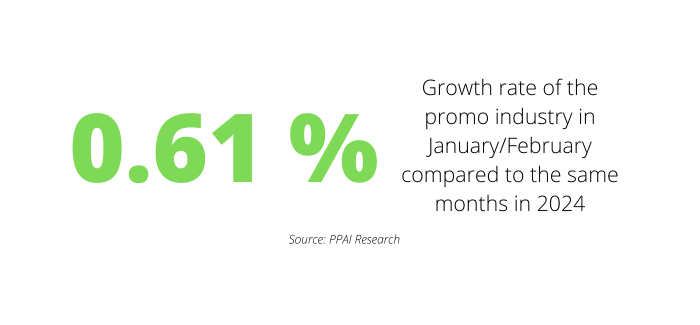A few months can make a world of difference.
Last December, PPAI Research published its bi-monthly report concerning October and November, focusing on year-over-year revenue growth. In those months, the promotional products industry had increased by 2.43%, showing its strongest revenue growth of 2024 and leaving promo with a touch of optimism for 2025.
Data on the first two months of 2025 is showing considerably different results.
- In January and February, industry revenue grew by 0.61% compared to the same two-month period in 2024.
- This represents a smaller year-over-year growth than promo saw during any two-month stretch in 2024.
- Worse yet, this lags significantly behind the current inflation rate of 2.8%, which Fed Chair Jerome Powell has already predicted will rise due to President Donald Trump’s global tariffs.

According to Alok Bhat, market economist and PPAI’s research and public affairs lead, these numbers appear to be in contrast with the relative stability the industry saw in 2024.
“Promo’s growth was moderate for most of 2024, but it was also steady,” Bhat says. “As the year progressed, revenue was ticking upwards in the right direction. These first months of 2025 tell a different story. External factors, such as the threat of tariffs, seem to have already stunted the industry’s growth.”
RELATED: Trump Unveils Reciprocal Tariffs: ‘Declaration Of Economic Independence’
The latest revenue data isn’t cultivated from the same methodology as the annual U.S. Distributor Sales Volume Estimate, which polls U.S. distributors of all sizes. Rather, the current assessment stems from the aggregated results of PPAI 100 distributors and suppliers responding to a flash survey.
Looking past the dip in growth, there’s another departure compared to past bi-monthly surveys, which have often shown relatively similar growth numbers between distributors and suppliers. That was not the case in January and February, with 63% of PPAI 100 distributors reporting revenue growth compared to 39% of suppliers reporting increased revenue.

Alok Bhat
Market Economist, Research & Public Affairs Lead, PPAI
“Broadly speaking, the data shows that distributors are still enjoying growth, but suppliers are bearing the brunt of supply chain challenges, a dynamic that will likely catch up to many distributors if the numbers continue in this direction,” Bhat says.
The developments shown in this bi-monthly survey could bring anxious eyes to the next available report. With tariffs being one of the potential causes of the dip in growth, it’s worth noting that many of the current tariffs implemented by Trump had not yet gone into effect, or even been announced, during the months for which this survey covered.
Distributor Reaction
The initial bi-monthly report of 2025 shows distributors weathering external factors, such as tariff uncertainty, with more ease than suppliers.
- Nearly two-thirds (63%) of PPAI 100 distributors saw sales revenue increases in January and February (compared to the same months in 2024). This is a more than 20% advantage over PPAI 100 suppliers.
- Less than a quarter (23%) of distributors saw a decline in sales revenue with 6% reporting significant decline.
Denise Taschereau, CEO of Vancouver-based distributor Fairware and PPAI Board Chair, says that distributors are operating resiliently to begin 2025 but the state of global trade is going to make continued growth only more difficult.
“While growth has slowed compared to the end of last year, it’s encouraging to see continued resilience across the industry, especially among distributors,” says Taschereau. “I’m expecting these small gains will be hard to maintain in the face of an all-out tariff war, but our industry has shown itself to be agile and value-driven in the past.”

Denise Taschereau
PPAI Board Chair
Supplier Reaction
Those who wouldn’t describe the first two months of 2025 as “unstable” from a global and economic standpoint would likely concede to “unpredictable.” While most of today’s current global tariffs had not gone into effect, the mere threat of them forced promo (and other industries) to react and, in many cases, prepare.
To whatever degree this began to affect the supply chain, it seems that it was suppliers who felt the burden first.
- Only 39% of PPAI 100 suppliers reported increases in sales revenue in January and February (7.3% saw significant increases).
- Relative stability was experienced by 27% of suppliers, who reported flat revenue, showing a degree of cautious resilience.
- Worryingly, nearly as many suppliers experienced declining revenues as those who saw increases. Over one-third of PPAI 100 suppliers (34%) reported a drop off in sales revenue. Worse yet, 5% claimed to experience “steep declines.”
According to Neil Ringel, CEO of PCNA, PPAI 100’s No. 3 supplier, says the industry maintaining growth amid an uncertain time is a positive insight to acknowledge, but the company is well aware of the factors that are creating a trepidatious environment.

Neil Ringel
CEO, PCNA
“This report highlights encouraging signs of resilience across our industry,” Ringel says. “While I am optimistic about the trend we’re seeing, we remain cautious that price inflation from tariffs poses a real risk to demand. We will continue to monitor developments closely and support strategies that help our partners stay competitive.”
For January and February, rising procurement costs seemed to become a factor, a development worth monitoring in the months that follow.
- More than half (53%) of PPAI 100 suppliers saw procurement cost increases with 10% reporting significant spikes.
With inflation putting pressure on margins, Bhat says firms will likely have to adjust in big or small ways to maintain the margins they need to operate with confidence.
“With inflation eroding profitability, firms must tighten cost controls, refine pricing and push for trade policy clarity to protect margins,” Bhat says.
___
The full report will be available to all Professional-tier members via Premium Research within two months.
Upgrade your PPAI membership here to receive access to the full report.


